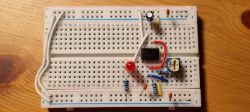FAQ
TL;DR: DIY horizontal band sawmills cut about 3 × Ø35 cm spruce logs per hour [Elektroda, marcingeneral, post #8478052]; “manual pushing is very light” [Elektroda, jantar2005, post #7953581] Hydraulic tension and correct roller set-up stop blade wander. Why it matters: These tweaks decide cut accuracy, belt life and safety for hobbyists building sub-€2 000 rigs.
Quick Facts
• Typical band speed: 25–30 m s⁻¹ for 35 mm blades (*Wood-Mizer Tech Sheet*).
• Recommended band tension: 16–18 MPa axial stress [Elektroda, dickens1, post #9772433]
• Material & machining cost for a basic head: ~PLN 3 000 [Elektroda, marcingeneral, post #7790507]; full project ~PLN 7 000 [Elektroda, jantar2005, post #7970876]
• Common drive motor: 4 kW, 1 400 rpm, star/delta start [Elektroda, marcingeneral, post #9311995]
• One sharp band lasts 40-60 min continuous cut before resharpening [Elektroda, mamba99, post #8190615]
What size and power motor should I mount on a home-built band mill?
A 4 kW, 1 400 rpm three-phase motor is proven for 35 mm blades on logs up to Ø35 cm [Elektroda, marcingeneral, post #9311995] Use a 1:1 pulley when the blade speed stays below 30 m s⁻¹. If you plan hardwood or thicker cants, step up to 5.5 kW for torque reserve (Wood-Mizer spec).
How do I tension the band correctly without snapping it?
Fit a hydraulic tensioner with a built-in gauge; crank until the indicator shows 16-18 MPa [Elektroda, marcingeneral, post #7790507] Over-tensioning by 20 % cuts band life in half and risks sudden rupture (Wood-Mizer Service Bulletin).
Where can I buy drive wheels or hubs in Poland?
Ready-to-mount 480 mm and 580 mm wheels plus hydraulic tensioners are sold on Allegro by user 4246949 [Elektroda, jantar2005, post #7970876] Hamech still stocks spare wheels for their factory mills [Elektroda, elktro, post #7969589]
Can I use car wheels or washing-machine pulleys instead?
Car rims with solid rubber tyres work if re-machined and balanced; washing-machine castings are only 300 mm Ø and fatigue-prone under 18 MPa tension [Elektroda, marcingeneral, post #7988544] Expect 10 % wider kerf deviation and shorter bearing life—acceptable for firewood, risky for lumber quality.
Why are my boards wavy even after sharpening?
Common causes: 1. Dull or poorly set teeth [Elektroda, bulineek, post #8109579] 2. Guide rollers not 3–5 mm below the drive wheel plane [Elektroda, jantar2005, post #17237975] 3. Feed too fast—slow until motor load drops under 80 %. 4. Loose tension below 16 MPa. 5. Misaligned track rails >1 mm over 1.5 m span [Elektroda, bulineek, post #8114208]
Is manual feed enough, or should I add an inverter drive?
Manual push lets you feel cutting resistance and adjust on the fly, reducing wave marks [Elektroda, jantar2005, post #7953581] Adding a 0.7 kW motor with VFD and chain reduction gives 0–25 m min⁻¹ adjustable travel [Elektroda, peloks, post #7819273]; include torque feedback or you’ll still outrun the blade in knots.
How high a cant can I cut with a 22 cm throat?
You’ll clear 22 cm in one pass. For 24 cm rafters, slice the log into 8 cm flitches, rotate, and resaw as shown in the four-cut strategy [Elektroda, jantar2005, post #7953581] Factory hobby mills (LT15) offer 28 cm throat for reference.
What’s the simplest track rail design that stays straight?
Weld a 6 m bed from 120 × 60 × 3 mm rectangular tube; add 100 × 60 × 3 mm cross-ties every 1.5 m [Elektroda, jantar2005, post #7957866] Cap one rail with a flat bar for wheel alignment and use adjustable axles to level [Elektroda, marcingeneral, post #7818070]
Which coolant system works best for resinous pine?
A 20 L canister, ball valve and flexible lathe coolant hose drip 50–100 ml min⁻¹ water+2 % soap on the blade [Elektroda, marcingeneral, post #7790507] Nozzles must wet both sides; dry cutting overheats and dulls teeth within 10 minutes on spruce [Elektroda, bulineek, post #8109579]
How often should I sharpen and set the teeth?
Change bands every 40–60 min of continuous sawing, then sharpen at 0.25 mm per face and reset every third grind [Elektroda, mamba99, post #8190615] A dedicated 230 V CBN sharpener pays off after 300 m³ sawn.
How long does a band last before it breaks?
With proper tension and rest cycles (>12 h between runs), users report 3 sharpenings and no breaks yet [Elektroda, marcingeneral, post #9118847] Industrial data show 200–300 m² lumber per band; sand contamination or overfeed halves that figure (USDA Forest Service).
What safety covers and switches are essential?
Add 2 mm steel or 4-layer glass-mat epoxy guards over both wheels to stop belt whip [Elektroda, donek901, post #7791284] Install an emergency mushroom stop that cuts the main contactor within 0.2 s; lack of covers is a cited liability risk [Elektroda, Karolo1001, post #10976492]
Quick 3-step guide: aligning guide rollers
- Set blade tension to 16 MPa.
- Position each roller 3 mm below the drive wheel plane, edge 6 mm behind the gullet.
- Lock twin eccentrics; spin blade by hand and confirm zero lateral drift. Re-check after first cut.
What happens if I over-tighten the blade by mistake?
Exceeding 20 MPa stretches the band beyond its 0.2 % yield; micro-cracks appear within 5 cuts and sudden break can eject shards at 60 m s⁻¹ (Wood-Mizer Safety Note). Always release tension overnight to avoid metal fatigue.





